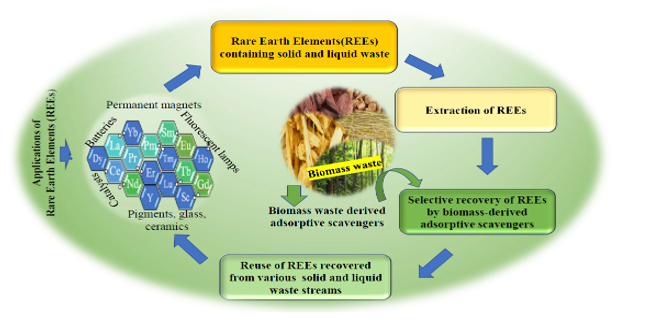Video Article Open Access
A General Overview on Biomass-Derived Adsorptive Scavenger Materials for Rare Earth Elements (REEs) Recovery
Varsha Srivastava*, Ulla Lassi
Research Unit of Sustainable Chemistry, University of Oulu, P.O. Box 3000, Oulu, FI-90014, Finland
Vid. Proc. Adv. Mater., Volume 3, Article ID 2206289 (2022)
DOI: 10.5185/vpoam.2022.06289
Publication Date (Web): 13 Sep 2022
Copyright © IAAM
Graphical Abstract

Abstract
Rare earth elements (REEs) are employed in a wide range of applications, including the manufacturing of catalysts, paints, adsorbents, fluorescent lamps, permanent magnets, sensors, batteries, and a wide range of other electrical and electronic devices[1,2]. Due to their limited availability and continuous rising in global demands, it is crucial to develop effective technologies for the recovery of REEs from secondary raw materials to meet the demand and supply chain [3,4]. To alleviate the supply threats, reclamation of REEs from secondary resources such as spent battery waste (NiMH batteries), permanent magnets, fluorescent lamps, and industrial side streams are the points of strategic focus [1,3]. The hydrometallurgical approach for extraction of REEs results in the generation of REEs-laden acidic drainage. Recovery of REEs from this acidic drainage can be done via solvent extraction, ion exchange, adsorption, precipitation, ultrafiltration (UF), electrochemical approaches, etc. Among all, the more favorable technique is the direct recovery of REEs by efficient adsorptive scavengers [1,5]. However, the process of recovery of REEs requires adsorptive scavengers to be highly stable and effective in their selective recovery from complex acidic drainage. Efficient functional adsorptive scavengers’ materials for REEs recovery are thus critical for achieving efficient recovery of REEs at lower concentrations. In the recent years, biomass-derived/supported inorganic/organic adsorptive scavengers have received considerable attention in metal recovery [1,4,5]. Due to the availability of inherent functional groups of biomasses, more active sites are available for selective recovery of REEs from acidic drainage which makes biomass a suitable support material for tailoring of adsorptive scavengers. In this literature-based paper, we have reviewed biomass-based inorganic/organic scavengers along with their potential application in REEs recovery. A discussion has been made regarding the important aspects on the impact of synthesis parameters on morphological characteristics of biomass-based adsorptive scavengers and the influential parameters in REEs selective capture are evaluated. Biomass feedstocks have shown a significant impact on the scavenger properties hence need a deeper understanding for tailoring of adsorptive scavengers from biomass. Biomass-derived adsorptive scavengers exhibit good potential for the selective recovery of REEs. However, there is a need to evaluate the practical utility of biomass-derived adsorptive scavengers on a commercial scale.
Keywords
Adsorbent, adsorption, biomass waste; cellulosic materials, rare earth elements.
Acknowledgement
Authors acknowledge the Academy of Finland (project no.: 346537).
References
- S. Mahajan, V. Srivastava, M. Sillanpää, Sep. Purif. Technol., 2021, 258.
- A. Porvali, V. Agarwal, M. Lundström, Waste Manag., 2020, 107, 66-73.
- M.S. Gasser, M.I. Aly, Int. J. Miner. Process., 2013, 121, 31–38.
- S. Iftekhar, D.L. Ramasamy, V. Srivastava, M.B. Asif, M. Sillanpää, Chemosphere., 2018, 204, 413-430.
- P. Wamea, M.L. Pitcher, J. Muthami, A. Sheikhi, Chem. Eng. J., 2022, 428, 131086.
Biography
Varsha Srivastava is a researcher (Principal Investigator-Academy of Finland project) at the Research Unit of Sustainable Chemistry, University of Oulu, Finland. She has worked as an Associate Professor at Jyvaskyla University, Finland. She is Specialty Chief Editor of the Chemical treatment section of Frontier in Environmental Chemistry. Her research interests include the synthesis of functional materials for environmental applications, layered double hydroxides (LDHs), Metal-Organic Frameworks (MOFs) and photocatalyst synthesis, separation and purification technology, wastewater treatment, Rare Earth Elements (REEs) recovery, biomass valorization, nutrient recovery. She has published 114 articles in various refereed international journals. Her publications have an h-index of 43 and have been cited over > 5110 times. Varsha Srivastava received her doctoral degree from the Indian Institute of Technology, B.H.U., Varanasi, India. During her past research career, she has received three prestigious awards/fellowships by Govt. of India which include National Doctoral Fellowship (NDF) by All India Council of Technical Education (AICTE); CSIR-Senior Research Fellowship from the Council of Scientific and Industrial Research; and Women Scientist Award (WOS-A) by the Ministry of Science and Technology, Department of Science and Technology, India. She has demonstrated active involvement in the supervision of Ph.D. and M.Sc. thesis. Dr. Srivastava has successfully extracted funding from different funding agencies in Finland. She is the member of Editorial Board of Journal of Membranes & Separation Technology and International Journal of Environmental Research and Public Health. Dr. Srivastava is acting as a reviewer of more than 33 peer-reviewed international journals. She is also the member of the Finnish Catalysis Society, International Water Association (IWA), and American Chemical Society.
Video Proceedings of Advanced Materials

Upcoming Congress







